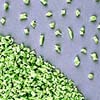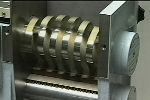| |

| |
| This is not a crusher, but a granulator.
Our GranCutter granulator provides you with top-quality recycled materials, and
it have a good reputation among the users. The 21st century is a generation of
recycling. Please try and see the effect of GranCutter swing and press cutting
system. | |
| Comparison with current granulators |
|
Much less dust | The
blade does not cut through material twice. This minimizes the amount of dust,
static electricity and heat. | |
Very few miss-cuts | The
spacing between the blades approximately duplicates the size of the original material
pellets, so sprues and runners get granulated to roughly the same dimension. There
are very few miss cuts. | |
Very quiet | Cutting
is held to a minimum, thus the machine is very quiet. | |
Very easy to clean | Because
there is minimal static electricity produced, and dust created doesn't adhere
to interior surfaces. Moreover, two large panel doors open downward to afford
greater cleaning convenience, and, ultimately, significantly shorten cleaning
time and downtime. (Average cleaning time: 5-7 minutes) | |
Soft materials acceptable | With
the SPC-S Series Grancutter, previously incompatible soft materials can now be
granulated. |
|
| Conventional Granulators |
 Conventional
rotary cutter granulators. when cutting sprues and runners that are larger than
the cutter height, leave pieces in a comb-like form.(See fig.1). The remaining
pieces, held in the cutters, inhibit the cutting of subsequent sprues and runners
and runners, and, while trapped, get repeatedly shaved into dust. In the case
of thin sprues and runners, cut pieces remain in a ring-like form on the stationary
cutters. (See fig. 2). Conventional
rotary cutter granulators. when cutting sprues and runners that are larger than
the cutter height, leave pieces in a comb-like form.(See fig.1). The remaining
pieces, held in the cutters, inhibit the cutting of subsequent sprues and runners
and runners, and, while trapped, get repeatedly shaved into dust. In the case
of thin sprues and runners, cut pieces remain in a ring-like form on the stationary
cutters. (See fig. 2).
Those pieces cannot be processed until the next sprues
and runners are added. While caught, they are also rubbed to dust.
|
| The
Grancutter | |  he
Grancutter utilizes a cam-driven swinging shaft rather than a rotating blade.
The patented system cuts the sprues and runners between teeth on the swinging
Shaft and teeth on a stationary blade mounted on the interior frame of the Grancutter.
(See fig. 3). he
Grancutter utilizes a cam-driven swinging shaft rather than a rotating blade.
The patented system cuts the sprues and runners between teeth on the swinging
Shaft and teeth on a stationary blade mounted on the interior frame of the Grancutter.
(See fig. 3).
When the swinging press cutter converges on the stationary
cutter, the sprues and runners are cut in the "bite" of the teeth, and
the granules are ejected from between the teeth of the cutters. The press cutter
swings open again, and the next sprues and runners fall between the teeth to be
cut. (See sequence of photos). There are no trapped pieces of sprues and runners,
thus no dust. There is also very little static electricity or heat produced
|
| The
Mechanics of the Grancutter | |  In
the case of cylindrical sprues and runners(See fig.4), the first blade of the
swinging press cutter cuts the bottom half, then the sprue or runner is cut lengthwise
by the second blade. The top half of the sprue or runner, as shown in fig.5, remains
above the blades. It fall between the teeth when the press cutter swings open
for the next " bite", and is then cut into granules. The result is that
the sprues and runners are thoroughly and reliably cut, not shaved into dust or
left uncut. In
the case of cylindrical sprues and runners(See fig.4), the first blade of the
swinging press cutter cuts the bottom half, then the sprue or runner is cut lengthwise
by the second blade. The top half of the sprue or runner, as shown in fig.5, remains
above the blades. It fall between the teeth when the press cutter swings open
for the next " bite", and is then cut into granules. The result is that
the sprues and runners are thoroughly and reliably cut, not shaved into dust or
left uncut.
 With
conventional granulators that are equipped with a screen, sprues and runners that
are smaller than the mesh can drop into the material tank without being cut. Miscuts
can occur. With the Grancutter system, however, because pieces of sprues and runners
remain above the blades if they are uncut, they cannot fall into the material
tank without being granulated. Furthermore, the sprues and runners are cut at
a right angle to the swinging shaft and are discharged between the teeth, Therefore,
there is nearly no erroneous cutting. With
conventional granulators that are equipped with a screen, sprues and runners that
are smaller than the mesh can drop into the material tank without being cut. Miscuts
can occur. With the Grancutter system, however, because pieces of sprues and runners
remain above the blades if they are uncut, they cannot fall into the material
tank without being granulated. Furthermore, the sprues and runners are cut at
a right angle to the swinging shaft and are discharged between the teeth, Therefore,
there is nearly no erroneous cutting.
|
With the SPC-S series Grancutter, it is now
possioble
to granulate soft-type resin sprues
and runners that could not be recycled. |

|  SOFT
TYPE GRANCUTTER SPC II-S Series] SOFT
TYPE GRANCUTTER SPC II-S Series]
 SPCII-400S SPCII-400S
 SPCII-750S SPCII-750S |
| The
soft-type Resin Grancutter | | End-users have repeatedly
expressed a concern that they could not recycle various elastomers and soft-type
resins that they use, and they wished there was a machine to granulate sprues
and runners of those materials for re-use. Until now, there was basically no way
to recycle elastomers and soft-type resins,and it was impossible to satisfactorily
use the discarded sprues and runners. In response, Harmo-Soken has developed the
SPC-S Series Grancutter, designed specifically to granulate those materials for
recycling. The significant difference of the SPC-S Series machines relative to
the SPC Series Grancutters is the clearance in the "bite" of the teeth.
Whereas the space between the "biting" teeth on the normal-material
machines is approximately 0.4mm, the gap on the SPC-S Series machines is under0.03mm.
If the gap is any larger, PP sprues and runners are stretched, not cut, and soft
elastomers are torn, not cleanly granulated. Due to this precision, the machine
must not be used for granulating materials other than those soft-type materials
specifically designated as compatible. |
Some examples of suitsble materials.
SPC-S SERIES
(For SOFT materials) |
 |  |  |  |
Polypropylene
Pic | Polyethylene
Pic | Thermoplastic
Elastomer
Pic | Polyurethne
Pic |
 |  The
Soft-type Resin Grancutter should not be used for Normal and Hard Materials. The
teeth are not designed to cut those materials, and damage to the machine occurs.
Do not attempt to granulate Normal and Hard Materials in the S-Series Grancutter.
Harmo-Soken is not responsible for any damage resulting from incompatible material(Normal
and Hard materialsÛjbeing granulated. The
Soft-type Resin Grancutter should not be used for Normal and Hard Materials. The
teeth are not designed to cut those materials, and damage to the machine occurs.
Do not attempt to granulate Normal and Hard Materials in the S-Series Grancutter.
Harmo-Soken is not responsible for any damage resulting from incompatible material(Normal
and Hard materialsÛjbeing granulated. |
|
| Movie |
Click image or title to see motion image.
| QuickTime
Movie | GIF
Animation | GIF
Animation |  |  |  |
| A total image of each different
blade moving in one continuous sequence, including overall movement of a rotary
blade and close-up of a moving blade. Also you find the casing is wide open for
easy cleaning. | Overall image of
a rotary blade with bigger image size. | Close-up
image of a moving blade actually cutting materials into small pieces with bigger
image size. | |
QuickTime 3 or 4 required
Length:42sec.
Image size : 160 * 120
File size : 717KB |
Length:Endless
Image size : 269* 215
File size : 345KB |
Length:Endless
Image size : 250* 190
File size : 530KB |
| 
|
| |

